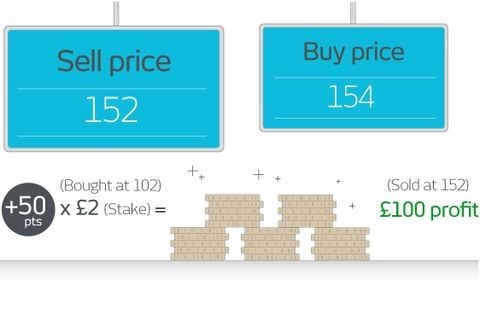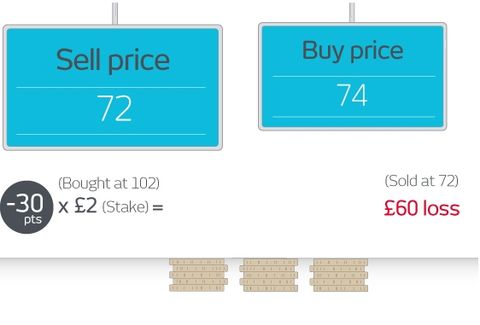Spread betting examples
Using the UK 100 and shares spread betting as an example, see how you can go long or short on the financial markets, depending on whether you expect prices to rise or fall.
Spread betting example 1: buying ABC Company shares
In this example, ABC Company is trading at 100/102 (where 100 is the sell price and 102 is the buy price). The spread is 2.
Let's assume that you want to open a buy position (go long) at £2 per point because you think the price of ABC Company will go up.
Let's say that our margin rate for ABC Company is 5%, which means that you only have to deposit 5% of the total position's value (position margin) to place your trade. Therefore, in this example, your position margin will be £10.20 (5% x (£2 x 102)).
Remember that if the price moves against you, it is possible to lose more than your outlay of £10.20, as losses will be based on the full value of the position.
Please note when spread betting equities an additional spread is built in to the spread bet price displayed on the platform and is applicable upon execution of any order.
Outcome A: winning bet
Your prediction was correct and ABC Company shares rise in value over the next week to 152/154. You decide to close your buy bet by selling at 152 (the current sell price).
The price has moved 50 points (152 sell price – 102 buy price) in your favour. Multiply this by your stake of £2 to calculate your profit, which is £100.

Outcome B: losing bet
Unfortunately, your prediction was wrong and the price of ABC Company drops over the next week to 72/74. You feel that the price is likely to continue dropping, so to limit your losses, you decide to sell at 72 (the current sell price) to close the bet.
The price has moved 30 points (102 - 72) against you. Multiply this by your stake of £2 to calculate your loss, which is £60.

Spread betting example 2: buying the UK 100
In this example the UK 100 is trading at 5789/5790 (sell price/buy price). Let's assume that you think the price of the UK 100 will go up and decide to go long (buy) at £2 per point. The UK 100 has a tier 1 margin rate of 0.25%, which means that you only have to deposit 0.25% of the total position's value as position margin. Therefore, in this example your position margin will be £28.95 (0.25% x (£2 x 5790)).
Outcome A: winning spread bet
Remember: if the price moves against you, it is possible to lose more than your investment of £28.95.
Your prediction was correct and the price rises over the next hour to 5830/5831. You decide to close your buy bet by selling at 5830 (the current sell price).
The price has moved 40 points (5830 – 5790) in your favour. Multiply this by your stake of £2 to calculate your profit, which is £80.
Outcome B: losing spread bet
Unfortunately, your prediction was wrong and the price of the UK 100 drops over the next hour to 5750/5751. You feel the price is likely to continue dropping, so to limit your losses you decide to sell at 5750 (the current sell price) to close the bet.
The price has moved 40 points (5790 - 5750) against you. Multiply this by your stake of £2 to calculate your loss, which is £80.
Spread betting example 3: selling the UK 100
In this example, the UK 100 is trading at 5789/5790. You think the price will go down and decide to sell the UK 100 at £2 per point. Remember, prices are always quoted with the sell price on the left and buy price on the right.
The UK 100 has a tier 1 margin rate of 0.25%, which means that you only have to put forward 0.25% of the position's value as position margin. In this example your position margin will be £28.95 (0.25% x (£2 x 5789)).
Remember that if the price moves against you, it is possible to lose more than your investment of £28.95.
Outcome A: winning spread bet
Your prediction was correct and the price goes down over the next hour to 5757/5758. You decide to close your sell bet by buying at 5758 (the current buy price).
The price has moved 31 points (5789 – 5758) in your favour. Multiply this by your stake of £2 to calculate your profit, which is £62
Outcome B: losing spread bet
Unfortunately, your prediction was wrong and the price of the UK 100 rises over the next hour to 5819/5820. You feel that the price is likely to continue increasing, so to limit your losses you decide to buy at 5820 (the current buy price) to close the bet.
The price has moved 31 points (5820 – 5789) against you. Multiply this by your stake of £2 to calculate your loss, which is £62.
Spread betting holding costs
If you hold any position after 5pm New York time, you will be charged a holding cost, or if the position has a fixed expiry the holding cost will be built into the price of the product.
We calculate the holding rate applicable to the holding cost based on the Interbank lending rate of the currency in which the product is denominated. For example, the UK 100 (pound sterling) is based on the Sterling Overnight Index Average (SONIA) interest-rate benchmark. For buy positions, we charge 0.0082% above SONIA and for sell positions you receive SONIA minus 0.0082%, unless the underlying risk-free or interbank rate is equal to or less than 0.0082%, in which case sell positions may incur a holding cost.
You can view the historic holding costs, per product, by clicking on the account menu and then the history tab.
Disclaimer: CMC Markets is an execution-only service provider. The material (whether or not it states any opinions) is for general information purposes only, and does not take into account your personal circumstances or objectives. Nothing in this material is (or should be considered to be) financial, investment or other advice on which reliance should be placed. No opinion given in the material constitutes a recommendation by CMC Markets or the author that any particular investment, security, transaction or investment strategy is suitable for any specific person.